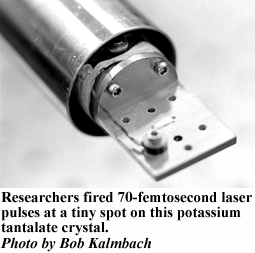The University Record, March 18, 1997
Physicists try to control atoms
 By Sally Pobojewski
By Sally Pobojewski
News and Information Services
Using ultrafast pulses of laser light, U-M physicists have found a way to control the random oscillations of atoms in a crystal lattice. The study, published in the March 13 issue of Science and being presented today at the American Physical Society meeting in Kansas City, describes the first experimental modification of one of the most fundamental quantum states of solid matter.
About 10 years ago, scientists discovered how to create this “squeezed” state for quantum particles of light energy called photons. Until the U-M experiment, no one has been able to do so with quantum particles called phonons, which carry vibrational energy through a solid.
“Our goal was to learn how to control matter—to tell the atoms what to do, rather than just watch them do something,” says physics Prof. Roberto Merlin, one of several authors of the article.
Appreciating the significance of the U-M study requires plunging into the murky world of quantum mechanics, which governs how matter and energy interact within and between atoms.
To visualize the atomic structure of a solid at the quantum level, a helpful analogy is to think of the atom as a cloud whose area is defined by the atom’s random motion within the solid—according to Alberto Rojo, assistant professor of physics and a co-author of the paper.
“We can calculate probabilities for an atom’s location within a specific area of uncertainty, but we can never know precisely where the atom will be,” Merlin said. “It’s like hide-and-seek. With short-pulse, high-power lasers, we can reduce the size of the volume where the atom can hide.”
“Points of higher density in the cloud represent points where the probability of finding the atom is higher,” Rojo says.
It helps to visualize the atoms in the lattice as bouncing balls tethered to a wall with a piece of elastic, Rojo explains. When the initial laser pulse strikes, it stretches the spring constant of the elastic, expanding the quantum limit or the original range of the atom’s movement. After the pulse passes, the elastic suddenly snaps back, reducing the atom’s range of movement to a fraction of its original size. For a very brief moment, equivalent to one-half its normal oscillation cycle time, the atom is squeezed below its quantum limit. This process repeats itself for many cycles until eventually the solid returns to equilibrium.
Others collaborating on the experiment included graduate student Gregory Garrett, who conducted the experiment; A.K. Sood, Indian Institute of Science, Bangalore, India; and John F. Whitaker, associate research scientist at the Center for Ultrafast Optical Science. The project was funded by the National Science Foundation, through its support for the Center for Ultrafast Optical Science, and the U.S. Army Research Office.

